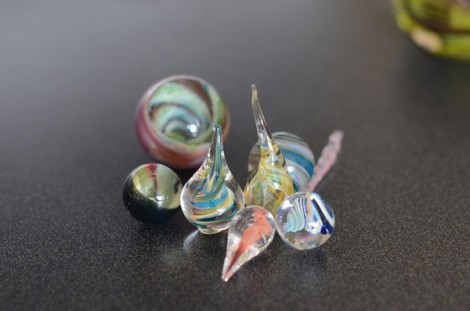Mike DiBona: It’s truly the most enjoyable thing I’ve done
June 9, 2014

What would you expect an artist to use when creating a masterpiece? Some artists use pencils, paints or clay, but others use a more unexpected medium: flames. Junior Mike DiBona has been practicing the art of glass-forming for one and a half years.
“It’s the only art form where you start with something so raw, and it becomes something so beautiful,” DiBona said. “That to me is the most enjoyable part, watching something progress from just a piece of glass to a beautiful marble or goblet.”
DiBona saw glass being blown when he was younger and decided to pursue his dream as a sophomore. He started by taking lessons and attending a summer camp program at Diablo Glass School, located in Boston. Since then, DiBona has been developing his skills by spending time at the studio independently.
“The easiest part of glassblowing is probably learning the techniques. You learn very quickly, probably because you get burned,” DiBona said. “The hardest part would be the success rate of the pieces you create because glass has a tendency to shatter under stress. When you’re working on a large marble for two hours under heat, right when you’re about to finish it, it might shatter into about 15 different pieces.”
DiBona forms glass using two techniques: glassblowing and flameworking. The two techniques differ in the process of melting the glass and the type of glass used.
“I personally specialize in flameworking,” DiBona said. “Instead of working with a large metal blow tube and reheating the glass by putting it in a big furnace, you work at a bench with a large torch that’s mounted on the bench.”

DiBona uses oxygen-propane torches to melt long rods made from borosilicate glass, a harder glass used in PYREX laboratory glassware and kitchenware. DiBona starts by placing the rod under the torch’s fire. He rotates the rod to keep the molten glass from dripping onto the workbench. From there, he uses a variety of tools to shape the piece.
“[The torches] get around 4000 to 4500 degrees Fahrenheit,” DiBona said. “Th[at] type of glass…is not the normal type of glass that people would work with [for glassblowing].
When flameworking, DiBona typically makes marbles, pendants, different kinds of jewelry or paperweights. However, when he blows glass, he typically makes things such as small cups and vases.
“In flameworking, you can’t make things that are usually bigger than a softball, which is being pretty generous,” DiBona said.
DiBona blows glass and flameworks at Diablo Glass School every weekend. He can be also be found working there as an assistant-teacher. He strongly encourages anyone interested in the art to try it out.
“When you’re working with something molten, it’s a little intimidating at first, but it’s so unique and so much different than any other art form,” DiBona said. “In my opinion, it’s probably the coolest form of art in terms of visual art.”
DiBona also plans to continue flameworking far into the future.
“I’d like to take it as far as I possibly can. It’s truly the most enjoyable thing I’ve done. It’s such a passion; it’d be foolish of me not to jump on that.”





![Last Wednesday, the Wayland School Committee gathered to discuss a number of topics regarding the health curriculum and Innovation Career Pathway course. Another large topic of conversation was the ways to potentially mitigate distracting cell phone usage. "These [phones] are going to distract your learning and social relationships," Superintendent David Fleishman said. "That's concrete right there."](https://waylandstudentpress.com/wp-content/uploads/2025/06/Screenshot-2025-06-04-at-9.49.31 PM-1200x886.png)



























![Troy Hoyt finishes the Boston Marathon, running for the Hoyt Foundation. T. Hoyt is the son of Hoyt Foundation CEO Russ Hoyt.
“[Running a marathon] might seem like a big thing, when it’s presented to you at first, but if you break it up and just keep telling yourself, “Yes, you can,” you can start chipping away at it. And before you know it, you’ll be running the whole 26 miles, and you won’t even think twice about it.” T. Hoyt said.](https://waylandstudentpress.com/wp-content/uploads/2025/04/C36E8761-1CBB-452E-9DF2-543EF7B1095E_1_105_c.jpeg)












































Mrs. Armentano • Jun 17, 2014 at 8:49 AM
Mike's work is amazing. His passion for creating in glass is evident when you see the variety of projects he has made. It's wonderful to see him using the principles he learned in glass blowing as a basis for other forms of art, too.